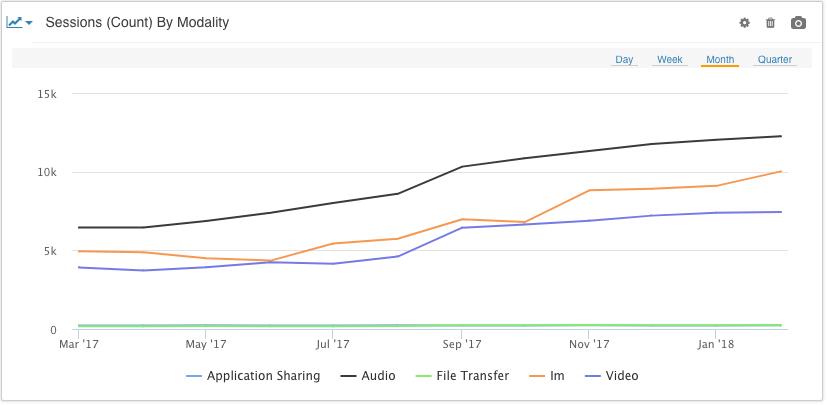
Collaboration is a hot topic today with companies like Facebook, Google, and Amazon all entering or expanding their presence in a big way last year. However, most discussions center around how new forms of collaboration will change businesses and people, but not enough attention is applied to how this evolution of collaboration changes networks.

Networks are key to so much of the technical advances our society is making today, and so much of the future is dependent on them as well. Pick a trend: Internet of Things, Artificial Intelligence, Machine Learning, Big data, and even Collaboration: all depend on the network to deliver the necessary data to enable the underlying technologies.
First, Scale
The fact is that these networks will have to scale and evolve to support a massive amount of real-time data. Networks today are built for data, not communication. Fundamentally, it’s all still 1’s and 0’s, but the difference can be major, especially as more people are doing live communication over these networks. In the days of telephone calls over dedicated telephone wires, planning your capacity was a pretty simple equation. Gauging your needs was a simple matter of calculating how many calls you might need at the same time. Coincidentally, this is still a need today for SIP Trunking, but I digress. Nowadays, calls include voice, video, and content – and frequently from multiple participants at the same time. In addition, the calls travel over the same internet as everything else (especially for cloud vendors), so the same bandwidth for collaboration has to support other data, like live video streams, emails, texts, and anything else the internet can produce.
But why does this matter? Networks ARE growing. Bandwidth is always going up.
It matters because bandwidth by itself isn’t enough.
The difference between the needs of collaboration data and other network applications is the instantaneous aspect of the packets being sent for live communication. You can’t simply retransmit and wait for all the packets to arrive to rebuild the original message like you can for images or streaming video (AKA buffering). Voice, video, and content for collaboration has to all arrive in order, on time to be of any use as live communication. Missed packets means lost seconds of video, unintelligible audio, or a dropped call.
At Vyopta, we work with IT teams because IT teams are the wizards behind the curtain who make sure collaboration happens reliably and effectively for every room and user in their network. In collaboration, the number of endpoints, users, and activities are proliferating rapidly. In addition, the format of collaboration is growing the fastest for cloud-based infrastructure. This is putting a huge strain on networks, and it is a strain that is very hard to predict and prepare for. This is increasing the challenge for our IT wizards.
Collaboration’s impact on Network: Practical Math
One of our best customers, a software company that is very advanced at collaboration, asked me yesterday if there were any tools to help predict the network load if his company moved entirely to the cloud for their video conferencing. I imagine this is a pretty common question out there today. The napkin math is astounding. If you imagine that user concurrency (the number of users that are in calls at the same time in a single location) peaks at around 1 out of every 4, then the bandwidth needs for a single office of a few hundred people quickly climbs into the Gigabits per second (Gbps).
For simplicity’s sake, let’s make the math easy.
1 call = 2/2 Mbps upload/download
500 calls in office = 1 Gbps upload and download.
Business Costs for 1Gbps = $500/month
In other words, for every 500 concurrent users you expect in an office, you will need to purchase $6K/year in bandwidth costs. So, if you expect peak traffic of 1 in every 4 users making a call, then you would need 1Gbps for every 2000 people in an office. This can get pretty pricey, especially when you have to account for other bandwidth needs for regular data traffic.
But it isn’t just bandwidth, right?
Bandwidth isn’t the only concern, however, your network needs to be robust in different ways for communication than it does for regular internet browser or data traffic.
- You need symmetric bandwidth: upload = download speeds
- Communication data is very deterministic: it needs to arrive in the right order at the right time (with a little bit of buffer). You can’t reconstruct live video.
- You need Quality of Service (QoS) policies in place – just in case. You need to be able to account for the ratio going over 1:4 (e.g. if a CEO broadcast happens)
- Monitoring software is needed to make sure it’s all working correctly.
This means you have overhead costs on top of the bandwidth to make sure the investments you have made are a) enough and b) being used effectively. It might also be a good idea to think about using technologies that are not ENTIRELY in the cloud. If there is some sort of on-premise deployment that can at least aggregate and compress data at a location or site level, that could help greatly to reduce the bandwidth and make it easier to manage.
Investing in the network is necessary
The bottom line is that the network is the foundation. You have to build a strong foundation. However, with the rate of change in collaboration and other technologies that rely on it, a strong foundation isn’t enough. You have to monitor that foundation, especially because you are basically just adding more stories to your building, adding new doors and windows, extending plumbing and electricity and generally changing your “building” every day.
You need to invest in your network, and you need to invest in tools to help you make sure that network is meeting the needs of your users, including collaboration. At Vyopta, we want to help. Let us know if you have any questions!



